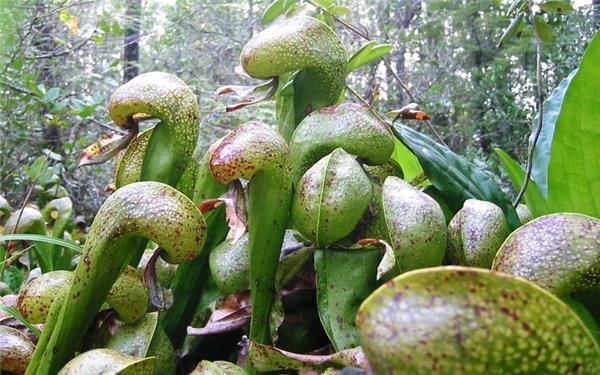One of the best choices for interior decoration of bottle grass
Bottle grass looks very beautiful, bottle-shaped leaves such as rosettes in a circle, spring protruding from a long scape, a drooping bowl of red flowers, very leafy. The following is a brief introduction to the breeding method of bottle grass.

The culture method of bottle grass
Bottle grass is generally used to split, cut, sow and propagate.
The split propagation of bottle grass was carried out from April to June before the new buds germinated. Cut the bottle grass from the rhizome into several small plants, and then plant them separately.
The propagation of bottle grass: first cut off the insect sac on the upper part of the leaf, then cut it together with a section of the stem at the base, and then put it into the basin after survival.
Sowing and propagation of bottle grass: from August to September, the seeds of bottle grass are sown on chopped water whips, uncovered. Under the condition of 20-25 ℃ air temperature and high relative humidity, it germinated in about 30 days. It takes about 3 years from sowing to plant maturity.

How to raise bottle grass
Soil: bottle grass prefers barren acidic soil. The matrix is made of peat soil, water moss, perlite and other materials, or it can be planted with peat soil alone. The bottom of the basin should be padded with broken bricks or pieces. Planting should not be too deep, so that half of the rhizome should be exposed to the soil. After planting, cover the basin with a small amount of moss to moisturize the basin, and then place the bowl in shallow water 3-4 meters deep.
Temperature: bottle grass likes to be warm in winter and cool in summer, and the suitable temperature for growth is 20-26 ℃, which is more hardy. In winter, the bottle grass is in the dormant period, the overwintering temperature should not be lower than-5 ℃, but it is best to maintain the temperature above 8C. Bottle grass is not resistant to drying and high temperature, so shading, spraying water and strengthening ventilation should be taken to reduce the temperature.
Lighting: bottle grass likes a semi-overcast environment, and strong sunlight will burn the leaf tube. Shade in summer, cover 50% of the sun, 60%, or put bottle grass in a place where there is enough scattered light to avoid direct sunlight. The rest of the time, you need plenty of light, which can make the bottle-shaped leaves more bright green and lovely. When the light is insufficient, the bottle grass will grow and the leaves will become dark.

Watering: bottle grass likes wet soil environment and is not resistant to drought. Bottle grass should be well watered during the growing period to keep the substrate moist. Watering should be controlled in winter and the soil can be slightly moist. The water temperature should be prevented from getting too high in summer, otherwise it will cause rotten roots. Rain Water should be used for watering. Avoid watering water containing calcareous matter.
Humidity: bottle grass is suitable to grow in a humid environment and is not resistant to drying, so bottle grass should often spray water to the plant and its surroundings during the growing period to keep the environment moist. It is necessary to spray water on the leaves of bottle grass in summer, which can not only reduce the environmental temperature, but also dry the environment is not conducive to plant growth.
Fertilization: in spring, bottle grass can be treated with nitrogen-based fertilizer every semimonthly, and the root can be irrigated with 0.2% copyright 0.3% fertilizer, or the diluted fertilizer can be directly poured into the pest bag for absorption. On the other hand, the bottle grass with red leaves and red veins should pay attention to the cooperation of nitrogen, phosphorus and potassium, so as to make the leaves bright and improve the ornamental value. Do not apply nitrogen fertilizer simply or too much, or the leaves will fade and fade. The fertilization of bottle grass should be light rather than thick, and thick fertilizer is easy to cause fertilizer damage. In winter, when the bottle grass is dormant, it should stop fertilizing.
Diseases and insect pests: bottle grass has leaf spot disease, root rot and aphids, shell insects, red spiders and other diseases and insect pests. It can be sprayed with 1000 times solution of omethoate or dicofol. The disease of bottle grass is mainly caused by root rot caused by water moss rot. At this time, the pot should be changed in time, the old plants should be removed, the rotten roots should be cut off and replanted.

That's all for today's introduction on the breeding method of bottle grass. I hope you like it!
Related
- Wuhan Hospital Iron Tree Blooming Result Was Instantly Frightened by the Gardener Master
- Which variety of camellia is the most fragrant and best? Which one do you like best?
- What is the small blue coat, the breeding methods and matters needing attention of the succulent plant
- Dormancy time and maintenance management of succulent plants during dormancy
- Minas succulent how to raise, Minas succulent plant pictures
- What are the varieties of winter succulent plants
- How to raise succulent plants in twelve rolls? let's take a look at some experience of breeding twelve rolls.
- Attention should be paid to water control for succulent plants during dormant period (winter and summer)
- Watering experience of twelve rolls of succulent plants
- Techniques for fertilizing succulent plants. An article will let you know how to fertilize succulent plants.



